Marketing Principles and Techniques: Whole Food Market Analysis Report
VerifiedAdded on 2020/10/22
|9
|2785
|429
Report
AI Summary
This report delves into marketing principles and techniques, using Whole Food Market as a case study. It begins with an introduction to core marketing concepts, including the marketing mix, market segmentation, and the importance of understanding customer needs. The report then explores market research methodologies, distinguishing between primary and secondary research, and outlines various market analysis tools and techniques, such as PEST analysis. Furthermore, it examines e-marketing strategies, including SEM, blog marketing, email marketing, and social media, and discusses how companies manage their online image. The report emphasizes the application of primary research methods and concludes with an interpretation of findings related to customer needs and preferences, providing valuable insights for marketing teams. It covers product selection, promotional activities and pricing strategies employed by the company to attract a large customer base. Finally, the report highlights how companies can enhance their online presence and maintain a positive brand image.
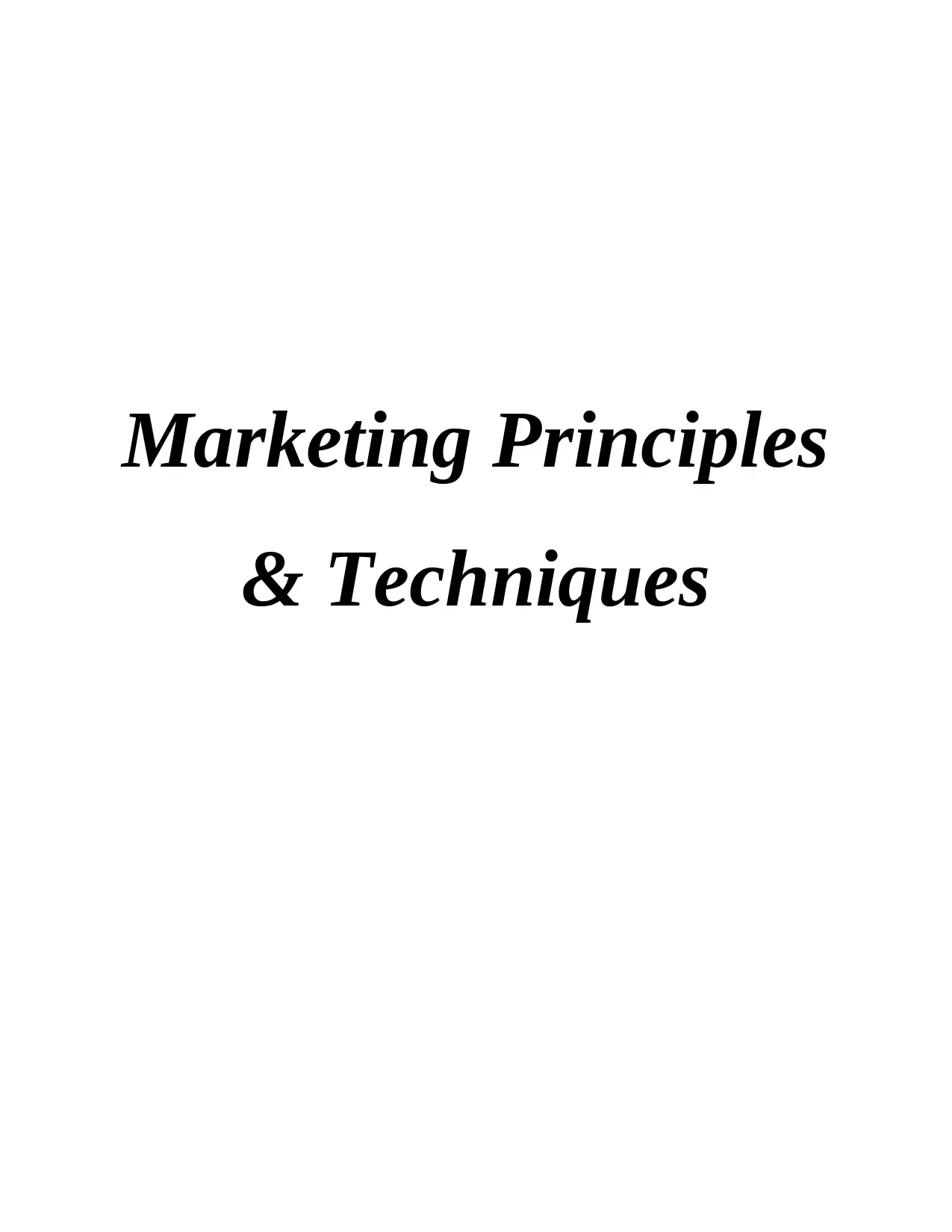
Marketing Principles
& Techniques
& Techniques
Paraphrase This Document
Need a fresh take? Get an instant paraphrase of this document with our AI Paraphraser
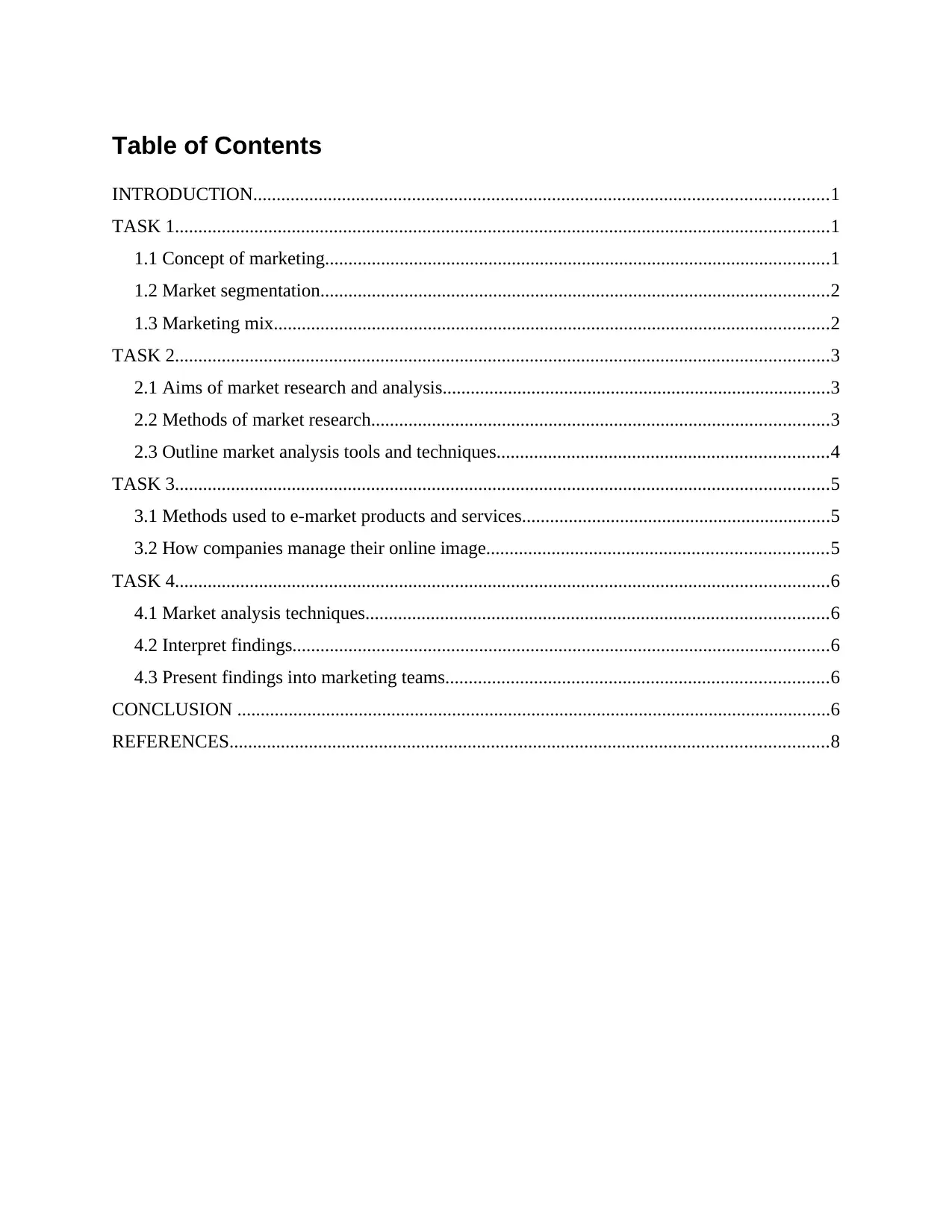
Table of Contents
INTRODUCTION...........................................................................................................................1
TASK 1............................................................................................................................................1
1.1 Concept of marketing............................................................................................................1
1.2 Market segmentation.............................................................................................................2
1.3 Marketing mix.......................................................................................................................2
TASK 2............................................................................................................................................3
2.1 Aims of market research and analysis...................................................................................3
2.2 Methods of market research..................................................................................................3
2.3 Outline market analysis tools and techniques.......................................................................4
TASK 3............................................................................................................................................5
3.1 Methods used to e-market products and services..................................................................5
3.2 How companies manage their online image.........................................................................5
TASK 4............................................................................................................................................6
4.1 Market analysis techniques...................................................................................................6
4.2 Interpret findings...................................................................................................................6
4.3 Present findings into marketing teams..................................................................................6
CONCLUSION ...............................................................................................................................6
REFERENCES................................................................................................................................8
INTRODUCTION...........................................................................................................................1
TASK 1............................................................................................................................................1
1.1 Concept of marketing............................................................................................................1
1.2 Market segmentation.............................................................................................................2
1.3 Marketing mix.......................................................................................................................2
TASK 2............................................................................................................................................3
2.1 Aims of market research and analysis...................................................................................3
2.2 Methods of market research..................................................................................................3
2.3 Outline market analysis tools and techniques.......................................................................4
TASK 3............................................................................................................................................5
3.1 Methods used to e-market products and services..................................................................5
3.2 How companies manage their online image.........................................................................5
TASK 4............................................................................................................................................6
4.1 Market analysis techniques...................................................................................................6
4.2 Interpret findings...................................................................................................................6
4.3 Present findings into marketing teams..................................................................................6
CONCLUSION ...............................................................................................................................6
REFERENCES................................................................................................................................8
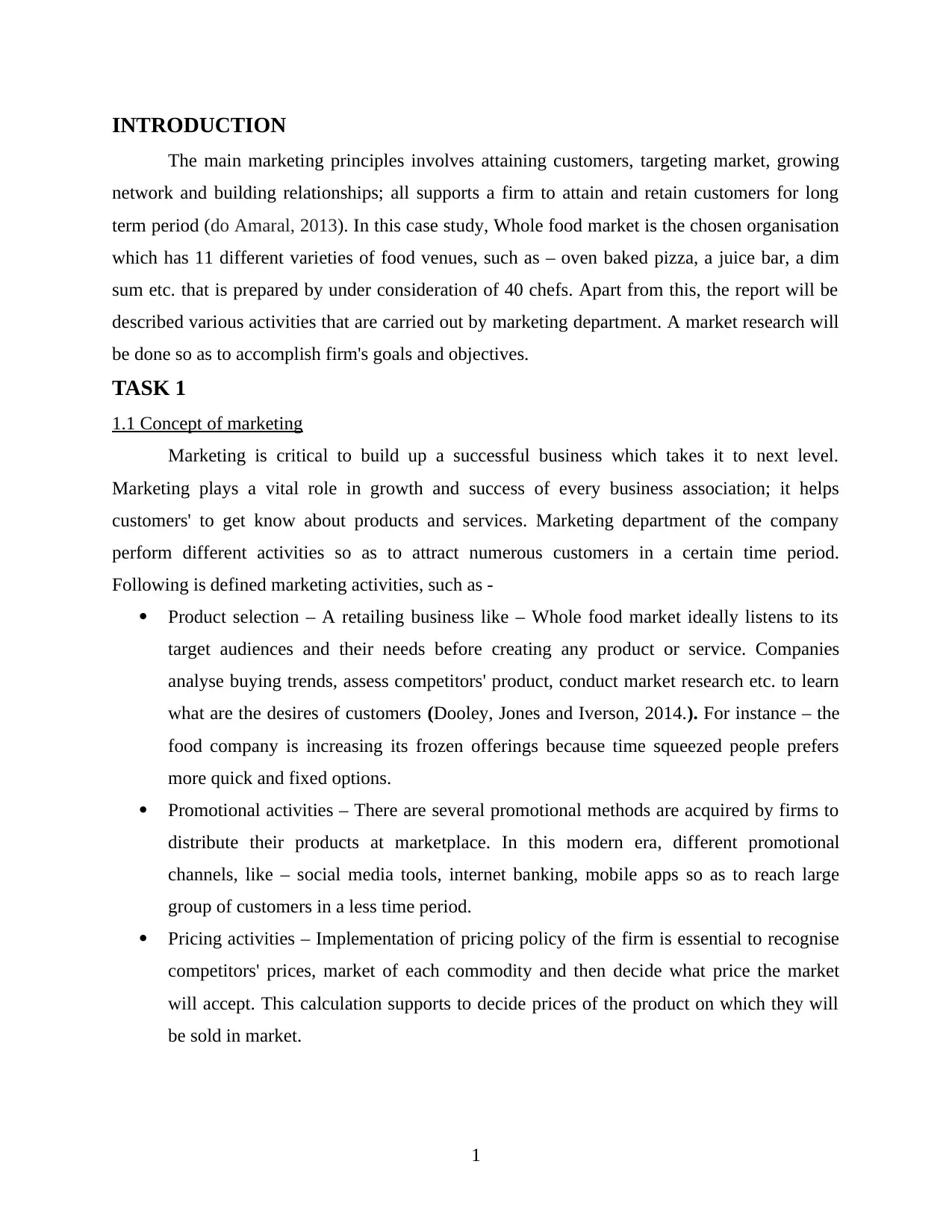
INTRODUCTION
The main marketing principles involves attaining customers, targeting market, growing
network and building relationships; all supports a firm to attain and retain customers for long
term period (do Amaral, 2013). In this case study, Whole food market is the chosen organisation
which has 11 different varieties of food venues, such as – oven baked pizza, a juice bar, a dim
sum etc. that is prepared by under consideration of 40 chefs. Apart from this, the report will be
described various activities that are carried out by marketing department. A market research will
be done so as to accomplish firm's goals and objectives.
TASK 1
1.1 Concept of marketing
Marketing is critical to build up a successful business which takes it to next level.
Marketing plays a vital role in growth and success of every business association; it helps
customers' to get know about products and services. Marketing department of the company
perform different activities so as to attract numerous customers in a certain time period.
Following is defined marketing activities, such as -
Product selection – A retailing business like – Whole food market ideally listens to its
target audiences and their needs before creating any product or service. Companies
analyse buying trends, assess competitors' product, conduct market research etc. to learn
what are the desires of customers (Dooley, Jones and Iverson, 2014.). For instance – the
food company is increasing its frozen offerings because time squeezed people prefers
more quick and fixed options.
Promotional activities – There are several promotional methods are acquired by firms to
distribute their products at marketplace. In this modern era, different promotional
channels, like – social media tools, internet banking, mobile apps so as to reach large
group of customers in a less time period.
Pricing activities – Implementation of pricing policy of the firm is essential to recognise
competitors' prices, market of each commodity and then decide what price the market
will accept. This calculation supports to decide prices of the product on which they will
be sold in market.
1
The main marketing principles involves attaining customers, targeting market, growing
network and building relationships; all supports a firm to attain and retain customers for long
term period (do Amaral, 2013). In this case study, Whole food market is the chosen organisation
which has 11 different varieties of food venues, such as – oven baked pizza, a juice bar, a dim
sum etc. that is prepared by under consideration of 40 chefs. Apart from this, the report will be
described various activities that are carried out by marketing department. A market research will
be done so as to accomplish firm's goals and objectives.
TASK 1
1.1 Concept of marketing
Marketing is critical to build up a successful business which takes it to next level.
Marketing plays a vital role in growth and success of every business association; it helps
customers' to get know about products and services. Marketing department of the company
perform different activities so as to attract numerous customers in a certain time period.
Following is defined marketing activities, such as -
Product selection – A retailing business like – Whole food market ideally listens to its
target audiences and their needs before creating any product or service. Companies
analyse buying trends, assess competitors' product, conduct market research etc. to learn
what are the desires of customers (Dooley, Jones and Iverson, 2014.). For instance – the
food company is increasing its frozen offerings because time squeezed people prefers
more quick and fixed options.
Promotional activities – There are several promotional methods are acquired by firms to
distribute their products at marketplace. In this modern era, different promotional
channels, like – social media tools, internet banking, mobile apps so as to reach large
group of customers in a less time period.
Pricing activities – Implementation of pricing policy of the firm is essential to recognise
competitors' prices, market of each commodity and then decide what price the market
will accept. This calculation supports to decide prices of the product on which they will
be sold in market.
1
⊘ This is a preview!⊘
Do you want full access?
Subscribe today to unlock all pages.

Trusted by 1+ million students worldwide
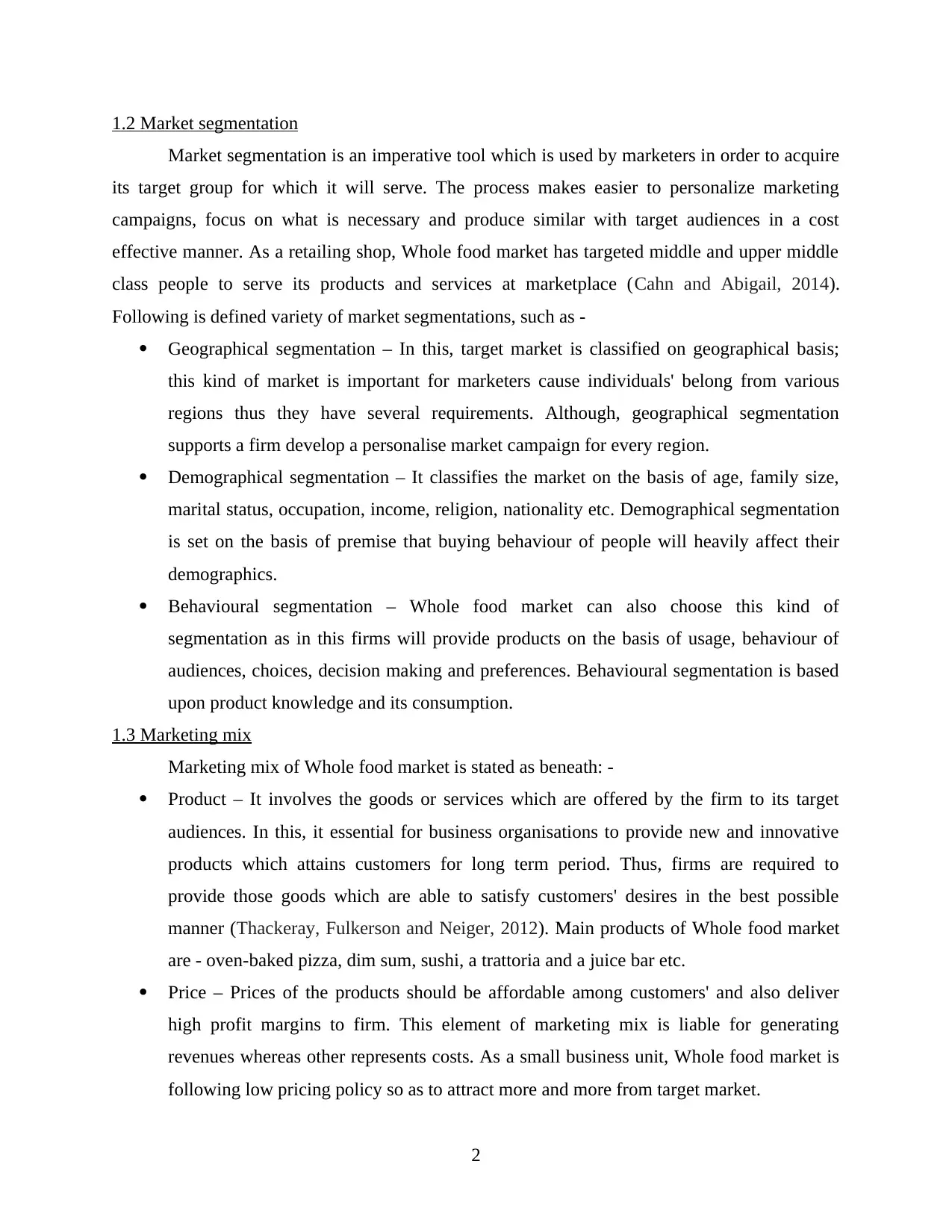
1.2 Market segmentation
Market segmentation is an imperative tool which is used by marketers in order to acquire
its target group for which it will serve. The process makes easier to personalize marketing
campaigns, focus on what is necessary and produce similar with target audiences in a cost
effective manner. As a retailing shop, Whole food market has targeted middle and upper middle
class people to serve its products and services at marketplace (Cahn and Abigail, 2014).
Following is defined variety of market segmentations, such as -
Geographical segmentation – In this, target market is classified on geographical basis;
this kind of market is important for marketers cause individuals' belong from various
regions thus they have several requirements. Although, geographical segmentation
supports a firm develop a personalise market campaign for every region.
Demographical segmentation – It classifies the market on the basis of age, family size,
marital status, occupation, income, religion, nationality etc. Demographical segmentation
is set on the basis of premise that buying behaviour of people will heavily affect their
demographics.
Behavioural segmentation – Whole food market can also choose this kind of
segmentation as in this firms will provide products on the basis of usage, behaviour of
audiences, choices, decision making and preferences. Behavioural segmentation is based
upon product knowledge and its consumption.
1.3 Marketing mix
Marketing mix of Whole food market is stated as beneath: -
Product – It involves the goods or services which are offered by the firm to its target
audiences. In this, it essential for business organisations to provide new and innovative
products which attains customers for long term period. Thus, firms are required to
provide those goods which are able to satisfy customers' desires in the best possible
manner (Thackeray, Fulkerson and Neiger, 2012). Main products of Whole food market
are - oven-baked pizza, dim sum, sushi, a trattoria and a juice bar etc.
Price – Prices of the products should be affordable among customers' and also deliver
high profit margins to firm. This element of marketing mix is liable for generating
revenues whereas other represents costs. As a small business unit, Whole food market is
following low pricing policy so as to attract more and more from target market.
2
Market segmentation is an imperative tool which is used by marketers in order to acquire
its target group for which it will serve. The process makes easier to personalize marketing
campaigns, focus on what is necessary and produce similar with target audiences in a cost
effective manner. As a retailing shop, Whole food market has targeted middle and upper middle
class people to serve its products and services at marketplace (Cahn and Abigail, 2014).
Following is defined variety of market segmentations, such as -
Geographical segmentation – In this, target market is classified on geographical basis;
this kind of market is important for marketers cause individuals' belong from various
regions thus they have several requirements. Although, geographical segmentation
supports a firm develop a personalise market campaign for every region.
Demographical segmentation – It classifies the market on the basis of age, family size,
marital status, occupation, income, religion, nationality etc. Demographical segmentation
is set on the basis of premise that buying behaviour of people will heavily affect their
demographics.
Behavioural segmentation – Whole food market can also choose this kind of
segmentation as in this firms will provide products on the basis of usage, behaviour of
audiences, choices, decision making and preferences. Behavioural segmentation is based
upon product knowledge and its consumption.
1.3 Marketing mix
Marketing mix of Whole food market is stated as beneath: -
Product – It involves the goods or services which are offered by the firm to its target
audiences. In this, it essential for business organisations to provide new and innovative
products which attains customers for long term period. Thus, firms are required to
provide those goods which are able to satisfy customers' desires in the best possible
manner (Thackeray, Fulkerson and Neiger, 2012). Main products of Whole food market
are - oven-baked pizza, dim sum, sushi, a trattoria and a juice bar etc.
Price – Prices of the products should be affordable among customers' and also deliver
high profit margins to firm. This element of marketing mix is liable for generating
revenues whereas other represents costs. As a small business unit, Whole food market is
following low pricing policy so as to attract more and more from target market.
2
Paraphrase This Document
Need a fresh take? Get an instant paraphrase of this document with our AI Paraphraser
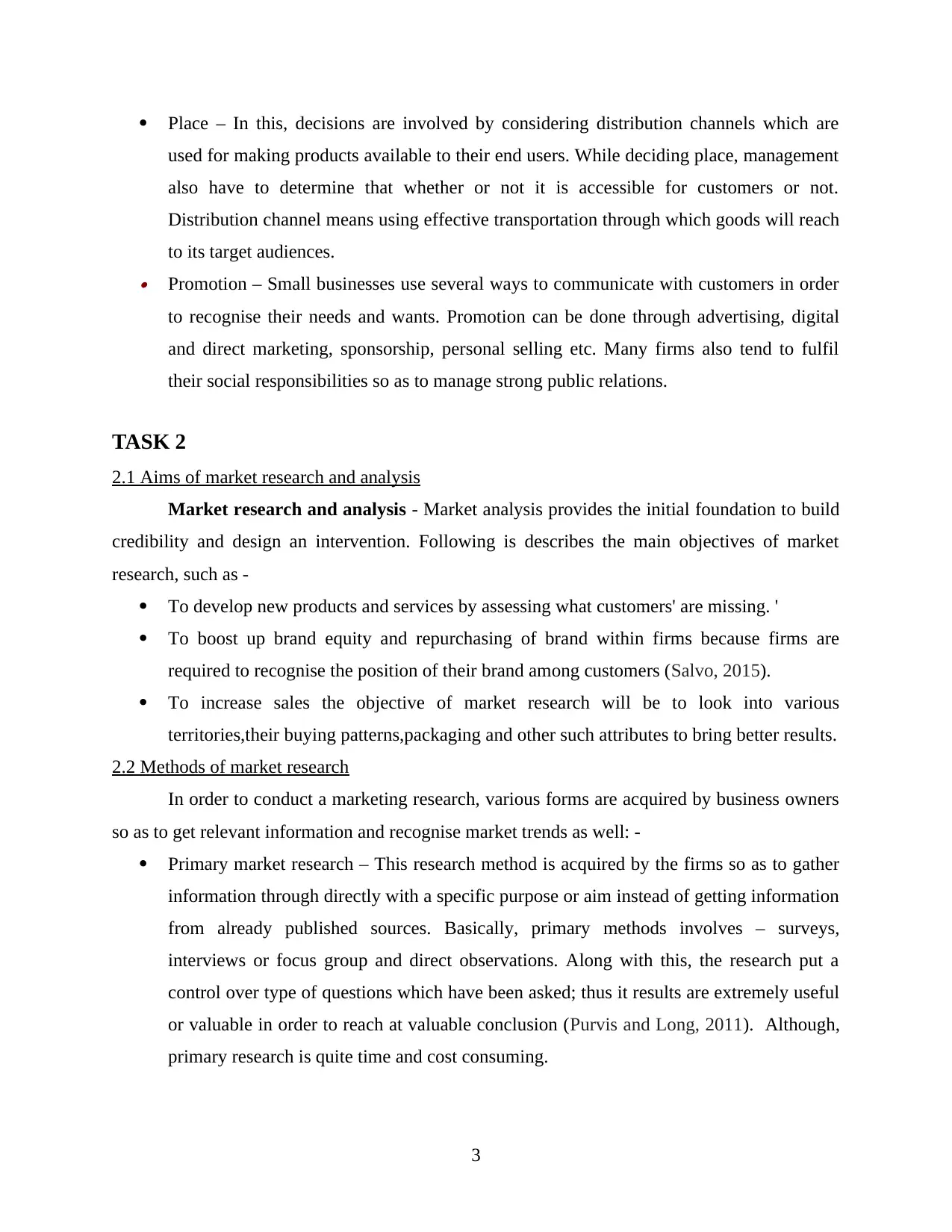
Place – In this, decisions are involved by considering distribution channels which are
used for making products available to their end users. While deciding place, management
also have to determine that whether or not it is accessible for customers or not.
Distribution channel means using effective transportation through which goods will reach
to its target audiences. Promotion – Small businesses use several ways to communicate with customers in order
to recognise their needs and wants. Promotion can be done through advertising, digital
and direct marketing, sponsorship, personal selling etc. Many firms also tend to fulfil
their social responsibilities so as to manage strong public relations.
TASK 2
2.1 Aims of market research and analysis
Market research and analysis - Market analysis provides the initial foundation to build
credibility and design an intervention. Following is describes the main objectives of market
research, such as -
To develop new products and services by assessing what customers' are missing. '
To boost up brand equity and repurchasing of brand within firms because firms are
required to recognise the position of their brand among customers (Salvo, 2015).
To increase sales the objective of market research will be to look into various
territories,their buying patterns,packaging and other such attributes to bring better results.
2.2 Methods of market research
In order to conduct a marketing research, various forms are acquired by business owners
so as to get relevant information and recognise market trends as well: -
Primary market research – This research method is acquired by the firms so as to gather
information through directly with a specific purpose or aim instead of getting information
from already published sources. Basically, primary methods involves – surveys,
interviews or focus group and direct observations. Along with this, the research put a
control over type of questions which have been asked; thus it results are extremely useful
or valuable in order to reach at valuable conclusion (Purvis and Long, 2011). Although,
primary research is quite time and cost consuming.
3
used for making products available to their end users. While deciding place, management
also have to determine that whether or not it is accessible for customers or not.
Distribution channel means using effective transportation through which goods will reach
to its target audiences. Promotion – Small businesses use several ways to communicate with customers in order
to recognise their needs and wants. Promotion can be done through advertising, digital
and direct marketing, sponsorship, personal selling etc. Many firms also tend to fulfil
their social responsibilities so as to manage strong public relations.
TASK 2
2.1 Aims of market research and analysis
Market research and analysis - Market analysis provides the initial foundation to build
credibility and design an intervention. Following is describes the main objectives of market
research, such as -
To develop new products and services by assessing what customers' are missing. '
To boost up brand equity and repurchasing of brand within firms because firms are
required to recognise the position of their brand among customers (Salvo, 2015).
To increase sales the objective of market research will be to look into various
territories,their buying patterns,packaging and other such attributes to bring better results.
2.2 Methods of market research
In order to conduct a marketing research, various forms are acquired by business owners
so as to get relevant information and recognise market trends as well: -
Primary market research – This research method is acquired by the firms so as to gather
information through directly with a specific purpose or aim instead of getting information
from already published sources. Basically, primary methods involves – surveys,
interviews or focus group and direct observations. Along with this, the research put a
control over type of questions which have been asked; thus it results are extremely useful
or valuable in order to reach at valuable conclusion (Purvis and Long, 2011). Although,
primary research is quite time and cost consuming.
3
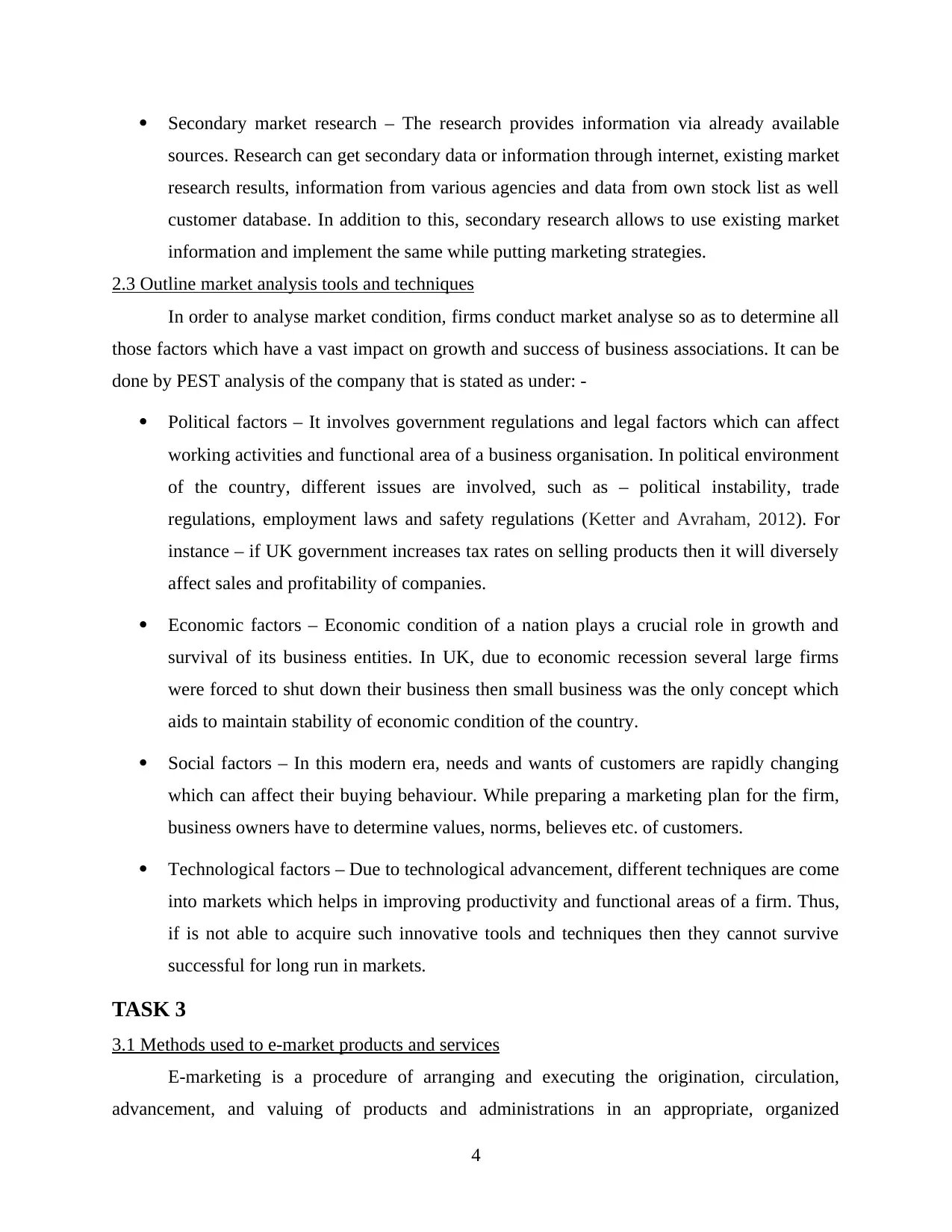
Secondary market research – The research provides information via already available
sources. Research can get secondary data or information through internet, existing market
research results, information from various agencies and data from own stock list as well
customer database. In addition to this, secondary research allows to use existing market
information and implement the same while putting marketing strategies.
2.3 Outline market analysis tools and techniques
In order to analyse market condition, firms conduct market analyse so as to determine all
those factors which have a vast impact on growth and success of business associations. It can be
done by PEST analysis of the company that is stated as under: -
Political factors – It involves government regulations and legal factors which can affect
working activities and functional area of a business organisation. In political environment
of the country, different issues are involved, such as – political instability, trade
regulations, employment laws and safety regulations (Ketter and Avraham, 2012). For
instance – if UK government increases tax rates on selling products then it will diversely
affect sales and profitability of companies.
Economic factors – Economic condition of a nation plays a crucial role in growth and
survival of its business entities. In UK, due to economic recession several large firms
were forced to shut down their business then small business was the only concept which
aids to maintain stability of economic condition of the country.
Social factors – In this modern era, needs and wants of customers are rapidly changing
which can affect their buying behaviour. While preparing a marketing plan for the firm,
business owners have to determine values, norms, believes etc. of customers.
Technological factors – Due to technological advancement, different techniques are come
into markets which helps in improving productivity and functional areas of a firm. Thus,
if is not able to acquire such innovative tools and techniques then they cannot survive
successful for long run in markets.
TASK 3
3.1 Methods used to e-market products and services
E-marketing is a procedure of arranging and executing the origination, circulation,
advancement, and valuing of products and administrations in an appropriate, organized
4
sources. Research can get secondary data or information through internet, existing market
research results, information from various agencies and data from own stock list as well
customer database. In addition to this, secondary research allows to use existing market
information and implement the same while putting marketing strategies.
2.3 Outline market analysis tools and techniques
In order to analyse market condition, firms conduct market analyse so as to determine all
those factors which have a vast impact on growth and success of business associations. It can be
done by PEST analysis of the company that is stated as under: -
Political factors – It involves government regulations and legal factors which can affect
working activities and functional area of a business organisation. In political environment
of the country, different issues are involved, such as – political instability, trade
regulations, employment laws and safety regulations (Ketter and Avraham, 2012). For
instance – if UK government increases tax rates on selling products then it will diversely
affect sales and profitability of companies.
Economic factors – Economic condition of a nation plays a crucial role in growth and
survival of its business entities. In UK, due to economic recession several large firms
were forced to shut down their business then small business was the only concept which
aids to maintain stability of economic condition of the country.
Social factors – In this modern era, needs and wants of customers are rapidly changing
which can affect their buying behaviour. While preparing a marketing plan for the firm,
business owners have to determine values, norms, believes etc. of customers.
Technological factors – Due to technological advancement, different techniques are come
into markets which helps in improving productivity and functional areas of a firm. Thus,
if is not able to acquire such innovative tools and techniques then they cannot survive
successful for long run in markets.
TASK 3
3.1 Methods used to e-market products and services
E-marketing is a procedure of arranging and executing the origination, circulation,
advancement, and valuing of products and administrations in an appropriate, organized
4
⊘ This is a preview!⊘
Do you want full access?
Subscribe today to unlock all pages.

Trusted by 1+ million students worldwide
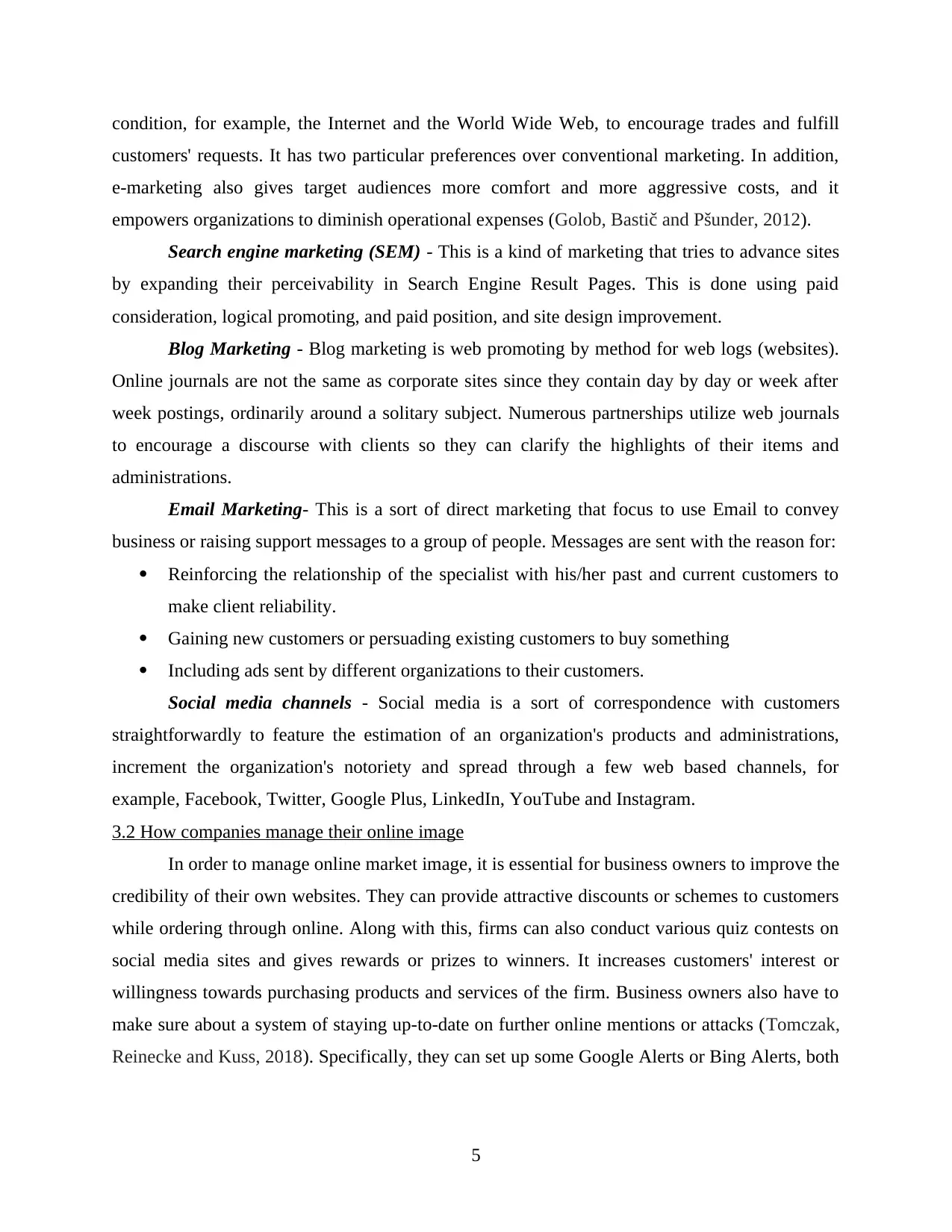
condition, for example, the Internet and the World Wide Web, to encourage trades and fulfill
customers' requests. It has two particular preferences over conventional marketing. In addition,
e-marketing also gives target audiences more comfort and more aggressive costs, and it
empowers organizations to diminish operational expenses (Golob, Bastič and Pšunder, 2012).
Search engine marketing (SEM) - This is a kind of marketing that tries to advance sites
by expanding their perceivability in Search Engine Result Pages. This is done using paid
consideration, logical promoting, and paid position, and site design improvement.
Blog Marketing - Blog marketing is web promoting by method for web logs (websites).
Online journals are not the same as corporate sites since they contain day by day or week after
week postings, ordinarily around a solitary subject. Numerous partnerships utilize web journals
to encourage a discourse with clients so they can clarify the highlights of their items and
administrations.
Email Marketing- This is a sort of direct marketing that focus to use Email to convey
business or raising support messages to a group of people. Messages are sent with the reason for:
Reinforcing the relationship of the specialist with his/her past and current customers to
make client reliability.
Gaining new customers or persuading existing customers to buy something
Including ads sent by different organizations to their customers.
Social media channels - Social media is a sort of correspondence with customers
straightforwardly to feature the estimation of an organization's products and administrations,
increment the organization's notoriety and spread through a few web based channels, for
example, Facebook, Twitter, Google Plus, LinkedIn, YouTube and Instagram.
3.2 How companies manage their online image
In order to manage online market image, it is essential for business owners to improve the
credibility of their own websites. They can provide attractive discounts or schemes to customers
while ordering through online. Along with this, firms can also conduct various quiz contests on
social media sites and gives rewards or prizes to winners. It increases customers' interest or
willingness towards purchasing products and services of the firm. Business owners also have to
make sure about a system of staying up-to-date on further online mentions or attacks (Tomczak,
Reinecke and Kuss, 2018). Specifically, they can set up some Google Alerts or Bing Alerts, both
5
customers' requests. It has two particular preferences over conventional marketing. In addition,
e-marketing also gives target audiences more comfort and more aggressive costs, and it
empowers organizations to diminish operational expenses (Golob, Bastič and Pšunder, 2012).
Search engine marketing (SEM) - This is a kind of marketing that tries to advance sites
by expanding their perceivability in Search Engine Result Pages. This is done using paid
consideration, logical promoting, and paid position, and site design improvement.
Blog Marketing - Blog marketing is web promoting by method for web logs (websites).
Online journals are not the same as corporate sites since they contain day by day or week after
week postings, ordinarily around a solitary subject. Numerous partnerships utilize web journals
to encourage a discourse with clients so they can clarify the highlights of their items and
administrations.
Email Marketing- This is a sort of direct marketing that focus to use Email to convey
business or raising support messages to a group of people. Messages are sent with the reason for:
Reinforcing the relationship of the specialist with his/her past and current customers to
make client reliability.
Gaining new customers or persuading existing customers to buy something
Including ads sent by different organizations to their customers.
Social media channels - Social media is a sort of correspondence with customers
straightforwardly to feature the estimation of an organization's products and administrations,
increment the organization's notoriety and spread through a few web based channels, for
example, Facebook, Twitter, Google Plus, LinkedIn, YouTube and Instagram.
3.2 How companies manage their online image
In order to manage online market image, it is essential for business owners to improve the
credibility of their own websites. They can provide attractive discounts or schemes to customers
while ordering through online. Along with this, firms can also conduct various quiz contests on
social media sites and gives rewards or prizes to winners. It increases customers' interest or
willingness towards purchasing products and services of the firm. Business owners also have to
make sure about a system of staying up-to-date on further online mentions or attacks (Tomczak,
Reinecke and Kuss, 2018). Specifically, they can set up some Google Alerts or Bing Alerts, both
5
Paraphrase This Document
Need a fresh take? Get an instant paraphrase of this document with our AI Paraphraser
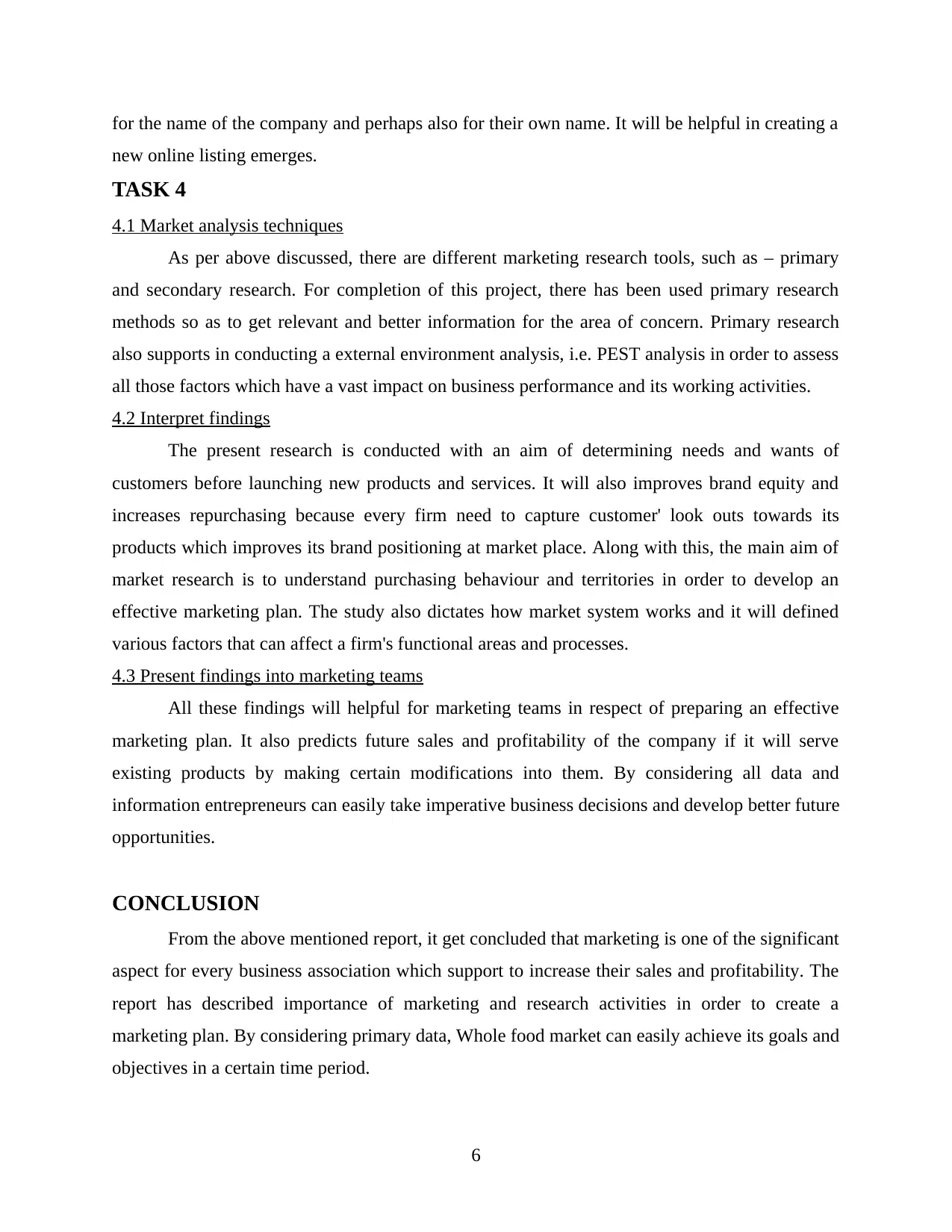
for the name of the company and perhaps also for their own name. It will be helpful in creating a
new online listing emerges.
TASK 4
4.1 Market analysis techniques
As per above discussed, there are different marketing research tools, such as – primary
and secondary research. For completion of this project, there has been used primary research
methods so as to get relevant and better information for the area of concern. Primary research
also supports in conducting a external environment analysis, i.e. PEST analysis in order to assess
all those factors which have a vast impact on business performance and its working activities.
4.2 Interpret findings
The present research is conducted with an aim of determining needs and wants of
customers before launching new products and services. It will also improves brand equity and
increases repurchasing because every firm need to capture customer' look outs towards its
products which improves its brand positioning at market place. Along with this, the main aim of
market research is to understand purchasing behaviour and territories in order to develop an
effective marketing plan. The study also dictates how market system works and it will defined
various factors that can affect a firm's functional areas and processes.
4.3 Present findings into marketing teams
All these findings will helpful for marketing teams in respect of preparing an effective
marketing plan. It also predicts future sales and profitability of the company if it will serve
existing products by making certain modifications into them. By considering all data and
information entrepreneurs can easily take imperative business decisions and develop better future
opportunities.
CONCLUSION
From the above mentioned report, it get concluded that marketing is one of the significant
aspect for every business association which support to increase their sales and profitability. The
report has described importance of marketing and research activities in order to create a
marketing plan. By considering primary data, Whole food market can easily achieve its goals and
objectives in a certain time period.
6
new online listing emerges.
TASK 4
4.1 Market analysis techniques
As per above discussed, there are different marketing research tools, such as – primary
and secondary research. For completion of this project, there has been used primary research
methods so as to get relevant and better information for the area of concern. Primary research
also supports in conducting a external environment analysis, i.e. PEST analysis in order to assess
all those factors which have a vast impact on business performance and its working activities.
4.2 Interpret findings
The present research is conducted with an aim of determining needs and wants of
customers before launching new products and services. It will also improves brand equity and
increases repurchasing because every firm need to capture customer' look outs towards its
products which improves its brand positioning at market place. Along with this, the main aim of
market research is to understand purchasing behaviour and territories in order to develop an
effective marketing plan. The study also dictates how market system works and it will defined
various factors that can affect a firm's functional areas and processes.
4.3 Present findings into marketing teams
All these findings will helpful for marketing teams in respect of preparing an effective
marketing plan. It also predicts future sales and profitability of the company if it will serve
existing products by making certain modifications into them. By considering all data and
information entrepreneurs can easily take imperative business decisions and develop better future
opportunities.
CONCLUSION
From the above mentioned report, it get concluded that marketing is one of the significant
aspect for every business association which support to increase their sales and profitability. The
report has described importance of marketing and research activities in order to create a
marketing plan. By considering primary data, Whole food market can easily achieve its goals and
objectives in a certain time period.
6
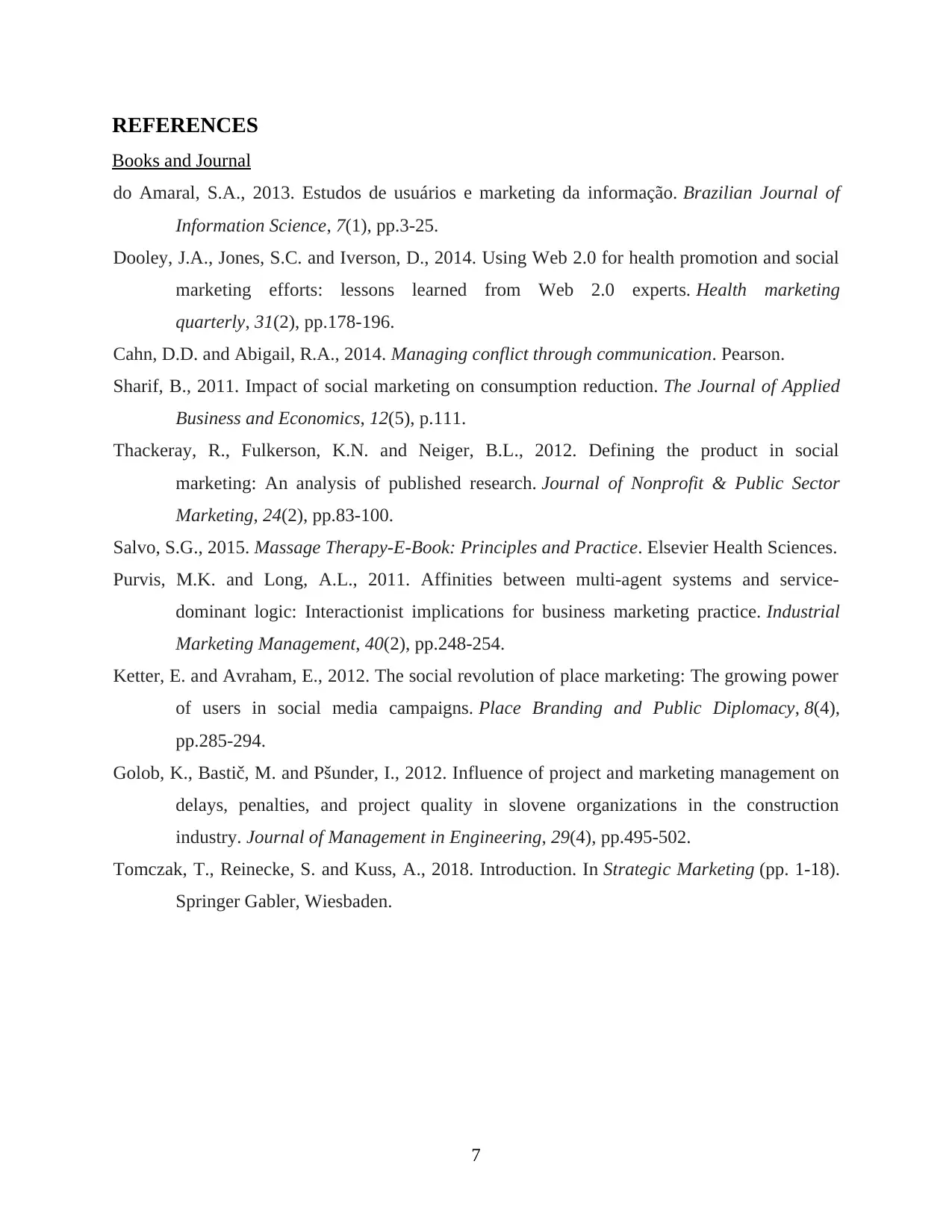
REFERENCES
Books and Journal
do Amaral, S.A., 2013. Estudos de usuários e marketing da informação. Brazilian Journal of
Information Science, 7(1), pp.3-25.
Dooley, J.A., Jones, S.C. and Iverson, D., 2014. Using Web 2.0 for health promotion and social
marketing efforts: lessons learned from Web 2.0 experts. Health marketing
quarterly, 31(2), pp.178-196.
Cahn, D.D. and Abigail, R.A., 2014. Managing conflict through communication. Pearson.
Sharif, B., 2011. Impact of social marketing on consumption reduction. The Journal of Applied
Business and Economics, 12(5), p.111.
Thackeray, R., Fulkerson, K.N. and Neiger, B.L., 2012. Defining the product in social
marketing: An analysis of published research. Journal of Nonprofit & Public Sector
Marketing, 24(2), pp.83-100.
Salvo, S.G., 2015. Massage Therapy-E-Book: Principles and Practice. Elsevier Health Sciences.
Purvis, M.K. and Long, A.L., 2011. Affinities between multi-agent systems and service-
dominant logic: Interactionist implications for business marketing practice. Industrial
Marketing Management, 40(2), pp.248-254.
Ketter, E. and Avraham, E., 2012. The social revolution of place marketing: The growing power
of users in social media campaigns. Place Branding and Public Diplomacy, 8(4),
pp.285-294.
Golob, K., Bastič, M. and Pšunder, I., 2012. Influence of project and marketing management on
delays, penalties, and project quality in slovene organizations in the construction
industry. Journal of Management in Engineering, 29(4), pp.495-502.
Tomczak, T., Reinecke, S. and Kuss, A., 2018. Introduction. In Strategic Marketing (pp. 1-18).
Springer Gabler, Wiesbaden.
7
Books and Journal
do Amaral, S.A., 2013. Estudos de usuários e marketing da informação. Brazilian Journal of
Information Science, 7(1), pp.3-25.
Dooley, J.A., Jones, S.C. and Iverson, D., 2014. Using Web 2.0 for health promotion and social
marketing efforts: lessons learned from Web 2.0 experts. Health marketing
quarterly, 31(2), pp.178-196.
Cahn, D.D. and Abigail, R.A., 2014. Managing conflict through communication. Pearson.
Sharif, B., 2011. Impact of social marketing on consumption reduction. The Journal of Applied
Business and Economics, 12(5), p.111.
Thackeray, R., Fulkerson, K.N. and Neiger, B.L., 2012. Defining the product in social
marketing: An analysis of published research. Journal of Nonprofit & Public Sector
Marketing, 24(2), pp.83-100.
Salvo, S.G., 2015. Massage Therapy-E-Book: Principles and Practice. Elsevier Health Sciences.
Purvis, M.K. and Long, A.L., 2011. Affinities between multi-agent systems and service-
dominant logic: Interactionist implications for business marketing practice. Industrial
Marketing Management, 40(2), pp.248-254.
Ketter, E. and Avraham, E., 2012. The social revolution of place marketing: The growing power
of users in social media campaigns. Place Branding and Public Diplomacy, 8(4),
pp.285-294.
Golob, K., Bastič, M. and Pšunder, I., 2012. Influence of project and marketing management on
delays, penalties, and project quality in slovene organizations in the construction
industry. Journal of Management in Engineering, 29(4), pp.495-502.
Tomczak, T., Reinecke, S. and Kuss, A., 2018. Introduction. In Strategic Marketing (pp. 1-18).
Springer Gabler, Wiesbaden.
7
⊘ This is a preview!⊘
Do you want full access?
Subscribe today to unlock all pages.

Trusted by 1+ million students worldwide
1 out of 9
Related Documents
Your All-in-One AI-Powered Toolkit for Academic Success.
+13062052269
info@desklib.com
Available 24*7 on WhatsApp / Email
![[object Object]](/_next/static/media/star-bottom.7253800d.svg)
Unlock your academic potential
Copyright © 2020–2025 A2Z Services. All Rights Reserved. Developed and managed by ZUCOL.





